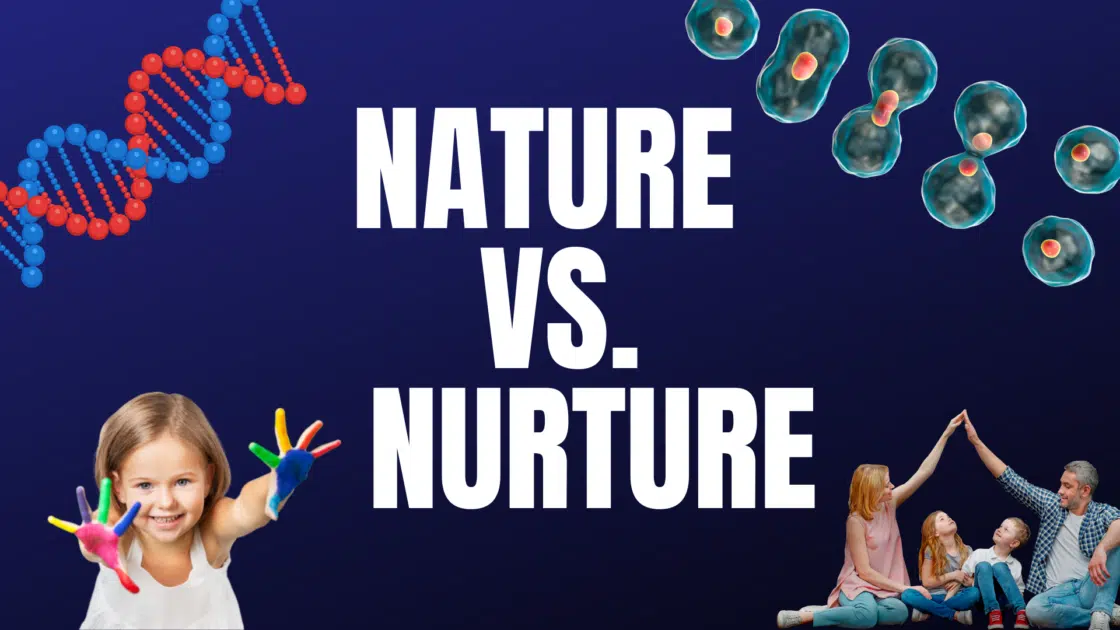
Nature Vs. Nurture – This is the Question.
The Nature vs. Nurture question is like the chicken and egg situation. What comes first? It’s hard to determine whether our genes or the environment have caused our disposition right now, especially in psychology.
This has been a serious debate among academicians and professionals for decades now. Truth be told, it has been one of the oldest debates in psychology.
Unfortunately, the discussion is still not over. If ever answered, it can significantly influence and impact our understanding of humans.
It can shed light on how behaviours are developed, how a language is learned, what increases a person’s risk of developing a mental illness, and more. The question goes to which particular aspects of behaviour are products of nature (i.e., genetic) or nurture (i.e., learned).
So let’s start to wade into the controversial issue of nature vs. nurture in psychology!
What does nature mean in psychology?

According to the American Psychological Association (APA) dictionary, nature is “the innate, presumably genetically determined, characteristics and behaviors of an individual. In psychology, the characteristics most often and traditionally associated with nature are temperament, body type, and personality”.
In a nutshell, nature refers to all genes and hereditary factors that influence who we are– from our physical appearance, body state and composition, personality, and characteristics.
Specific samples of biologically determined characteristics (aka nature) are:
- Certain genetic diseases – These diseases are caused by a problem in a person’s genes, which are contained within their genomes.
There are currently 6,000 known genetic disorders, and most are fatal or can cause severe problems. At the same time, others are less fatal but may add to issues that can be touched off by other non-genetic factors. - Eye colour – It is actually determined by differentials in one’s genes. In fact, most of the genes associated with eye colour are involved in the production, transport, or storage of a pigment called melanin.
The amount of melanin in the iris’s front layers is directly related to the person’s eye colour.1 - Skin colour – According to a study, the pigment melanin is the most determinant of people’s skin colour. The quantity and quality of melanin, much like eye colour, are regulated by the expression of genes.
- Life expectancy – As much as life expectancy is significantly influenced by environmental factors (e.g., smoking, excessive drinking, drug abuse, etc.), genes also play an essential role.
Scientists have found that first-degree relatives of long-lived individuals have a higher chance of remaining healthy and living longer than their peers.
There is already a study of longevity genes, but it is still developing science. However, what is known is that about 25% of the variation in the human life span is determined by genetics.
Regarding how nature or genes affect mental health, the National Institute of Mental Health (NIMH) states that certain mental disorders tend to run in families.
Having close relatives with mental health disorders may put you at a higher risk. Still, it does not necessarily mean you will develop one.
There are other diseases, including many mental illnesses, where gene variants increase or decrease a person’s risk of developing a particular condition.
In 2003, NIMH reported that scientists have long recognised that many psychiatric disorders run in the family, especially five mental disorders: autism, attention deficit hyperactive disorder (ADHD), bipolar disorder, major depression, and schizophrenia.
Genetic determinism is one of the core beliefs on the nature side, and it has two controversial views.
The first view argues that genetic factors alone are responsible for human beings’ behavioural traits and/or outcomes; however, no scientist nor intellectual believes in this.
The other view posts that individual and social genetic, rather than non-genetic factors, factors primarily cause variation in at least some vital behavioural traits and/or outcomes. 2
What does nurture mean in psychology?

While nature is all about genetic and hereditary factors, nurture, on the other hand, is about environmental variables.
This covers childhood experiences, how a children are raised, social relationships, culture, and social norms. All these variables impact who the person currently is.3
A person’s life experiences significantly affect their behaviour. People who constantly rely on substances such as alcohol or drugs are probably using them to cover or forget painful experiences in their lives.
People who develop eating disorders probably grew up with people who constantly criticise or bully them about their bodies.
People diagnosed with Post Traumatic Stress Disorder probably went through traumatic experiences such as accidents, abuse, war, and witnessing a crime, among many others.
According to an article, the five environmental factors that increase the risks of developing mental health problems are:
- Trauma – Trauma roots in physical, emotional, or sexual abuse during childhood. The trauma from this abuse can increase the chance of developing a mental illness.
- Stressful home environments – There are many examples of a stressful home environment. Their effects can also vary from one person to another.
This includes a household where parents are shouting and fighting; parents or other family members are substance abusers; parents are divorced or going through a divorce; poor home environment quality due to poverty; or toxic family relations. - Emotional disturbance – Most children experience emotional upset, such as bullying in school or at home, going through childhood with no friends, or having little to no emotional support while growing up.
- Substance abuse – Reliance on alcohol or substance abuse during the teenage to adult years can lead to mental health issues.
- Traumatic life experiences – This covers experiencing the death of a loved one, financial constraints (e.g., losing a job, going bankrupt. etc.), accidents, calamities, or war, among many others.
Specifically, trauma experienced by children districts their stability and sense of self, where they belittle their own worth and often stay with the child into adulthood.
Additionally, trauma can be carried over up to adulthood. People with trauma can experience shame and guilt, feel isolated and unable to relate to others, have a challenge in controlling emotions, or feel significant anxiety, depression, and/or anger.
Aside from these, six physical environmental factors may affect a person’s mental health. These are:
- Sleep deprivation – Good and enough sleep is integral for a healthy mental state.
- Environmental pollution – Growing up in an area with poor air quality quadruples a child’s chance of developing depression later in life. Of course, this is not solely restricted to air quality but also to other types of pollution.
- Hazardous working conditions – This refers to any working condition that puts significant stress and strain on the mind and body. If a person’s working environment is stressful, their mental health can also suffer.
- Extreme weather conditions – Living in a place where bad or extreme weather conditions are constrained can take a toll on any person, especially when they endanger their lives or their loved ones.
- Passive or active smoking – These two are incredibly harmful to one’s health– physical and mental.
- Inaccessible architecture – Inaccessible architecture can be very frustrating. It can isolate a person from areas or activities that can give them joy, which is why it can contribute to mental illness.
Other factors under nurture, while not as significant as those mentioned above, are:
- Lack of access to green spaces
- Lack of visual stimulation
- Oppressive untidiness
While these are not as significant as the others, their impacts on one’s mental health should not be undermined.
There is a concept of “Blank Slate” in psychology, commonly known as Tabula Rasa. The term has two definitions– one mainly used in human development while the other one in psychoanalysis.
The former refers to the belief that all humans are born with the ability to be anything or anyone, which, in a way, trivializes the effects of genetics and biology on the formation of human personality.
On the flip side, the latter refers to a technique therapists use when they become “blank” and allow the person to project all their own needs, desires, and beliefs onto them.
When did the debate over nature vs. nurture start?

When literature says that nature vs. nurture is an age-old debate, it is indeed quite a medieval one. In fact, the discussion started merely four years after the end of the American Civil War–1865.
In 1869, an English Polymath named Francis Galton coined “Nature Versus Nurture.” Galton is a man who wears many hats. He is an anthropologist, eugenicist, tropical explorer, geographer, invention, meteorologist, proto-geneticist, psychometrician, and statistician.
Surprisingly, Charles Darwin is also his cousin. He was intrigued by his cousin’s publication of On The Origin of Species (1859), which sets him to research further into the nature versus nurture debate, especially in the world of inheritance and evolution of traits.
According to his work Natural Inheritance (1889), he believes that intelligence is mainly inherited. While he favours nature over nurture, he also asserted that evolution assured the survival of the best physical and mental traits.4
While Galton coined it, John Locke, one of the greatest philosophers in Europe, popularised the notion. He asserted that humans are born with a blank slate.
Moreover, he firmly believes that the person’s environment– upbringing and life experiences- shapes their personality.5
More than a century later, this psychology debate has progressed into a new phrase: nativism and Empiricism. Nativism vs. Empiricism has the same thrust as Nature Vs. Nurture– Nativism emphasises that people are born with innate traits, while Empiricism contends that all knowledge is derived from experience.
Can nature and nurture work together?

While other scientists and intellectuals maintain that the age-old debate of nature vs. nurture is yet to be answered, a research article now argues that separating the two is both impossible and unproductive.
Another journal article states that social scientists and scientists have declared the debate to be officially redundant and ‘outdated, naive and unhelpful‘.
So the critical question remains: can nature and nurture work together? YES!
These two can definitely work together, especially in psychology. Again, there is no point in arguing between the two since both have been equally effective.
Matt Ridley, author of the book Nature via Nurture, found that genes influence human behavior, and human behavior influences genes.
I’m sure most people have been led to believe that genes are set in stone, however, research shows that early experiences can influence how genes are turned on and off and whether these will be expressed.
Science now tells that interactions between genes (nature) and environment (nurture) build human development. Putting it in laymen’s terms: the healthy development of organs depends on the activation of specific genes and their tasks.
At the same time, a person’s childhood experience has a significant role in developing one’s brain architecture. This brain architecture is the foundation of all future learning, behaviour, and health.
In conclusion, it’s crucial to ensure that children have appropriate and growth-promoting early experiences to hone their ability to become healthy and productive members of society.6
What are the developments in the debate?

There are a lot of existing studies on this debate; however, one of the biggest challenges that intellectuals face is the methodology of the experiment.
Indeed, it is impossible to remove either nature or nurture from a person just to study only the influence of the other. Scientists cannot simply isolate a newborn child from anyone to see if all things are caused by nature or nurture.
One of the closest experiments of this nature is the study of feral children, which is actually known in the academic world as the forbidden experiment.
A wild child is a person who has been isolated from society from a very young age and has had little or no experience of human interaction, behaviour, and even language.
There are three famous feral children cases; however, each study has its unique conclusions, but all were considered by the community as failures.7
Hopes were renewed, however, when the community realised the twins were ideal case respondents. A Twin studies is designed to measure the contribution of genetics instead of the environment.
Twin studies collated from all over the world over the past 50 years concluded that the average variation of human traits and diseases is 49% due to genetic factors and 51% due to environmental factors.
This revolutionary finding was accomplished by Beben Benyamin from the Queensland Brain Institute and other VU University of Amsterdam researchers. They collated 2,748 studies involving more than 14.5 million pairs of twins.
In addition to this, there were other exciting findings the study reported:
- The risk for bipolar disorder was 68% due to genetics and 32% to environmental factors.
- The risk for eating disorders was 40% genetics and 60% environmental factors.
- The risk for mental and behavioral disorders due to the use of alcohol was reported to be 41% genetics and 59% environmental factors.
- Most psychiatric, ophthalmological, and skeletal traits are more influenced by genetic factors.
- Social values and attitudes are shaped mainly by environmental factors.
Wile Nature vs. Nurture should no longer be an open debate; unfortunately, others still digress from these studies and are persistent in having their own answers.
At this point in time— more than a century after, scientists should move on and start to put their interest in how these two factors work together.
Sexuality: Nature or Nurture?

Aside from behavior, personality, and attitude, sexuality is also one of the hot topics debated in the Nature vs. Nurture debate.
LGBT members and psychologists would always say that being homosexual is not a choice, and that is a fact. However, the discussion of whether sexuality is primarily due to biological or environmental factors remains.
So, how is sexuality formed?
The first study that explored the biological explanation for sexuality was in 1957. The researcher, Karen Hooker, looked at the relationship between homosexuality and psychological development and illness.
The respondents, both homosexuals and heterosexuals, were given three psychological tests. Hooker found no significant differences in the two groups’ answers and concluded that sexuality is not based on environmental factors.
This research is a game changer for the LGBT community since it was used as the basis by the American Psychiatric Association to remove homosexuality from its Diagnostic and Statistical Manual of Psychological Disorders in 1973.
Two years after this landmark decision, a public statement was released that homosexuality was not a mental disorder.
There have been other numerous studies since, and most of them point to biological factors. This, however, is still not resolute since there is so much more on sexuality that psychologists and other intellectuals need to unpack and study.
How is nature vs. nurture used in therapy?

Nature and nurture are also significant elements in therapy. As a matter of fact, therapists use two approaches: nature-based and nurture-based.
The former approach addresses mental problems from a genetic or biological standpoint, such as prescribing medications to treat mental health issues. These medications, such as anti-anxiety or anti-depressants, aim to fix the chemical imbalance that causes a mental illness.
On the other hand, the latter approach addresses a person’s beliefs, behaviours, and experiences. Talk therapy is a type of nurture therapy where a therapist addresses a person’s emotions related to one’s affairs.
This is not a black or white scenario– most therapists combine both nature and nurture approaches in practice. One example of this is Cognitive Behavioural Therapy (CBT), where both are used and other factors.























